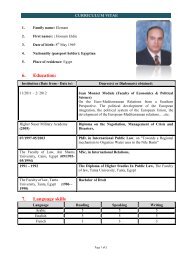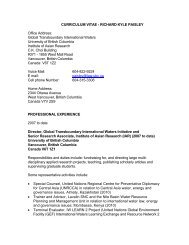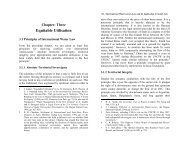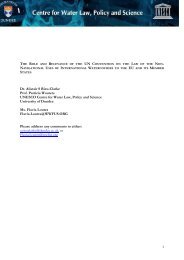Upreti, Trilochan, International Watercourses Law and Its Application ...
Upreti, Trilochan, International Watercourses Law and Its Application ...
Upreti, Trilochan, International Watercourses Law and Its Application ...
Create successful ePaper yourself
Turn your PDF publications into a flip-book with our unique Google optimized e-Paper software.
40 / <strong>International</strong> <strong>Watercourses</strong> <strong>Law</strong> <strong>and</strong> <strong>Its</strong> <strong>Application</strong> in South Asia Development <strong>and</strong> Codification of <strong>International</strong> <strong>Watercourses</strong> <strong>Law</strong> / 41the US Government to initiate proceedings against suchharmful activity <strong>and</strong> to seek compensation for whateverdamage had already occurred. The United States <strong>and</strong> CanadianGovernments signed a convention in Ottawa in 1935 <strong>and</strong>constituted an arbitral tribunal accordingly. 61 The tribunalrendered its decision in 1938 <strong>and</strong> 1941:"Under the principles of international law, … nostate has the right to use or permit the use of itsterritory in such a manner as to cause injury byfumes in or to the territory or another or theproperties or persons therein, when the case is ofserious consequence <strong>and</strong> the injury is establishedby clear <strong>and</strong> convincing evidence." 62Canada was held responsible in international law for theconduct of the Trail smelter. Therefore, the Trail smelter wasrequired to refrain from causing any harm through fumespassing over the state of Washington. While this case has nodirect relation to the subject of this research, the decision, hasfar reaching implications in the development of internationallaw as a whole <strong>and</strong> especially modern internationalenvironmental law. 63 This principle is largely complied with,followed <strong>and</strong> appreciated by the international community. As aresult of such recognition the Trial Smelter principles havebecome a significant part of customary rules of internationallaw. 64 This decision is cited in many national <strong>and</strong> internationalcases, state practices <strong>and</strong> writings. The maxim sic utre tuo,propounded for the first time in this case, has been followed inmany cases including the Lake Lanoux <strong>and</strong> Corfu Channel,quoting the concept of 'use your own resources without61 Supra note 36, pp. 192-194; also see 35 AJIL (1941) pp. 684-716.62 Supra note 57, p. 244.63 Supra note 56.64 35 AJIL (1941) pp. 684-716.affecting others.' 65 It should be understood that this judgementhas an explicit link with the 'no harm rule', stipulated in Article7 of the 1997 UNCIW, Article 21 of the UN Conference on theHuman Environment, 1972 66 <strong>and</strong> Article 2 of the UNConference on Environment <strong>and</strong> Development, 1992. 67 Theseare the basic foundations for no harm rules. For the purpose ofthis book, use of waters in an IWC is the right of riparian stateswith the obligation of prohibition of any harm to otherwatercourse states. In the event of any harm to the otherriparian, such harm must be mitigated, averted or eliminated.Furthermore, this is the foundation stone for the concept ofextraterritorial water pollution, no harm rule <strong>and</strong> environmentallaw.2.4.3 Lake Lanoux Case, 1957 France - SpainThis case is more significant than the earlier cases in relation tothe development of IWL, due to the fact it is explicitly relatedto the allocation <strong>and</strong> sharing of fresh waters in an IWC. 68 Thecase was decided by an arbitral tribunal constituted by theparties according to their Arbitration Treaty of 1929. Bothstates signed a Compromise in 1956. 69The outlet of Lake Lanoux in the eastern Pyrenees of Franceflows into the Carol River. In order to generate hydropower,France proposed to divert the Lake Lanoux waters over amountain drop into the Friege River in France <strong>and</strong> later thesame quantum of water was to drain into the Carol River. Spainobjected to the diversion of the waters, contending that it would65 C. B. Bourne, "The Development of <strong>International</strong> Water Resources:The Drainage Basin Approach" (1969) in 47 CBR, pp. 72-76.66 P. W. Birnie & A. E. Boyle, Basic Documents on <strong>International</strong> <strong>Law</strong><strong>and</strong> the Environment, New York: Oxford University, 1996, pp.1-8.67 Ibid. pp. 9-1468 R. Bernhard (ed), Encyclopaedia of Public <strong>International</strong> <strong>Law</strong>:Decision of <strong>International</strong> Courts <strong>and</strong> Tribunal <strong>and</strong> <strong>International</strong>Arbitration, the Hague: North-Holl<strong>and</strong> Company, 1981, pp. 166-167.69 24 ILR (1961), p. 101; also see 53 AJIL (1959), p. 156.












